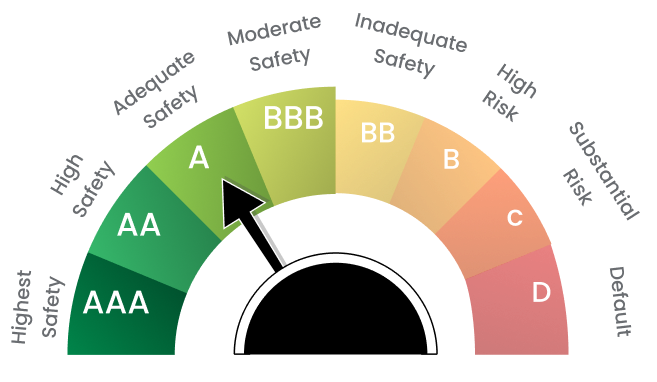What are Bonds?
Bonds are fixed income instruments, which the governments and entities issue to raise money for financing their projects, expenditures and other activities. In this, the investor purchasing bonds basically lends money to the bond-issuing entity. In return, the entity pays interest at periodical intervals (typically monthly/quarterly). When the bond reaches its maturity date, the bondholder gets back the principal value (face value) of the bond. Thus, bondholders can be considered as creditors for the bond issuers.
Why Invest in Bonds through Paisabazaar?
- High returns – Earn fixed returns of up to 13.25%.
- Low risk – Invest in a range of highly rated (AAA-BBB) corporate bonds.
- Flexible payout – Get fixed returns credited in your demat linked bank account every month/ quarter.
- Low investment – Start investing with as little as Rs. 1,000.
- Safety & security – Invest in SEBI-regulated senior secured bonds to enjoy higher claim priority over shareholders in case of default or liquidation.
- Sell anytime – Sell bonds anytime through Paisabazaar.
- Transparency – Real-time price discovery and assured transaction.
- No brokerage/commission – Invest without paying brokerage or commission fee.
- End-to-end digital process – Enjoy seamless end-to-end digital process.
How to Buy Bonds through Paisabazaar?
You can invest in top rated AAA-BBB bonds through Paisabazaar’s website and mobile app. To get started, follow the steps below:
Step 1: Login to your Paisabazaar account (link to bonds marketplace – wwww.paisabazaar.com/investment-bonds)
Step 2: Select the bond
Step 3: Complete the KYC process
Step 4: Enter bank details
Step 5: Link your demat account
Types of Bonds
- Corporate Bonds: Listed Public sector and private sector companies issue corporate bonds for financing their operations, expansion, debt consolidations, etc.
- Central Government Bonds: Central government issues these bonds for tenures of 5 to 40 years with their interest payments at half yearly intervals.
- State Development Loans (SDL): State governments in India issue State Development Loans (SDLs). They are almost as secure as Central Government Bonds.
- Municipal Bonds: Urban local bodies issue Municipal Bonds to raise money for financing various development projects.
- Zero Coupon Bonds: These bonds do not offer any coupon (interest) payments to investors.
- Capital Gains Bonds: These bonds help individuals and Hindu Undivided Families (HUFs) save on Long-Term Capital Gains (LTCG) tax liability arising from the sale or transfer of their land or building.
- Floating Rate Bonds: The interest or coupon payments of these bonds are linked to predetermined benchmark rates, which if changes could also change the bond’s coupon rate.
- Convertible Bonds: These bonds can be converted into shares after a specified period, either at the current market price or at a price pre-determined at the time of the bond issue.
- Callable Bonds: In these bonds, issuers have the right to buy back these bonds before their maturity dates.
How are Bonds Rated?

Benefits of Investing in Bonds
- Steady Income Stream: Bonds usually offer fixed interest at regular intervals, providing investors a steady income stream.
- Capital Preservation: The principal of bonds is repaid at maturity, making them ideal for those seeking capital protection amid market volatility.
- Diversification: Investing in bonds can offset the risks associated with more volatile assets like stocks.
- Lower Volatility: Bonds usually show lower price volatility than stocks, offering stability to risk-averse investors.
- Predictable Returns: Bonds offer fixed interest and guarantee to return the principal at maturity, helping investors estimate their future returns and plan their finances in advance.
- Potential for Capital Gains: Investors usually hold bonds for income, however, they can also provide profits if they are sold at higher prices before maturity.
Things to Consider Before Investing in Bonds
Here are a few points that investors should consider before investing in bonds:
- Check the bond issuer’s credit rating: This is a preliminary but important check as it will help you filter out riskier bond options from your list. Usually, AAA rated bonds are the safest bet with a very low chance of default.
- Look into the bond issuer’s financial health: Don’t solely rely on credit ratings, make sure to look at the bond issuing entity’s financials too such as balance sheet, P&L account, leverage ratios, etc. to evaluate corporate bonds.
- Check if the bond is secured or unsecured: This is applicable to corporate bonds. A secured corporate bond is backed by assets of the bond issuing entity and therefore, are safer than unsecured bonds. In case the bond issuer closes down or defaults on its repayment obligations, the pledged assets can be sold off to repay the bondholders. Among the secured bondholders, senior secured bondholders will be the first to receive repayments (right after payment of statutory and tax dues).
- Check the frequency of coupon payment: Bonds offer coupon payments at regular intervals, i.e., monthly, quarterly, half-yearly and annually. Before you start investing in a bond, check the frequency of its coupon payments and ensure that it matches with your cash flow requirements.
- Compare YTM: Yield to Maturity of a bond is the annualised rate of return if the investors holds the bond till its maturity date. Thus, always compare the YTM of a bond and remember to check its credit rating also. As lower credit rating bonds have higher YTM and vice versa, make sure that you make your pick as per your risk appetite.





